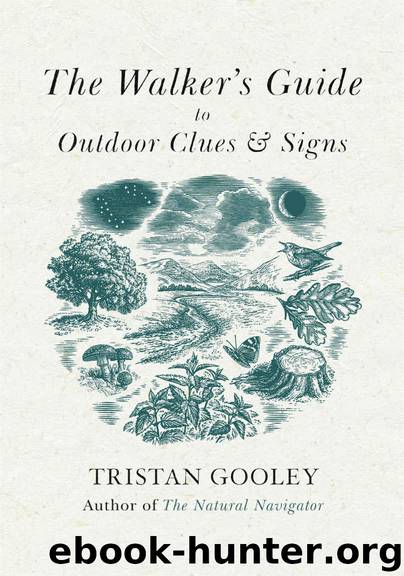The Walker's Guide to Outdoor Clues and Signs by Tristan Gooley

Author:Tristan Gooley [Gooley, Tristan]
Language: eng
Format: azw3
Publisher: Hodder & Stoughton
Published: 2014-05-07T16:00:00+00:00
A line from the horns of a high crescent moon, extended to your horizon gives a rough indication of south, from northern latitudes.
A full moon will rise roughly opposite the direction of sunset on that day. So full moons rise well south of east in midsummer and well north of east in midwinter.
Moonlight
In the chapter about the sun we saw how total shadows are very rare during the day, as the light from the sky, ‘airlight’, will give at least a little illumination to the parts that the sun cannot reach directly. However, the moon is not bright enough to light the sky itself and we get next to no airlight at night. There will be a modest amount of light from the stars, but nothing compared to the daytime sky.
This means that any area not receiving direct moonlight will be in the moon’s shadow and moon shadows are pitch black. If something is in direct moonlight, your eyes will often be able to make out plenty of details of shape, although very little colour. In the shadows, however, you will see next to nothing. This can have profound consequences when walking on even gentle hills at night.
The slope facing the moon will not be much harder to walk on than it is during the day, but the slopes facing away from the moon will be a different and much trickier matter. If you are sly, you can time a walk to the west so that the moon follows you over a crest and holds a lantern for you all the way.
Download
This site does not store any files on its server. We only index and link to content provided by other sites. Please contact the content providers to delete copyright contents if any and email us, we'll remove relevant links or contents immediately.
Ultimate Navigation Manual by Lyle Brotherton(2055)
Welcome to the Goddamn Ice Cube by Blair Braverman(1888)
The Box by Marc Levinson(1866)
Diver Down by Michael Ange(1422)
Animal Speak by Ted Andrews(1383)
Backcountry Bear Basics by Dave Smith(1361)
Living_by_the_Code_v1.1.1 by 2019(1246)
The Backpackers Handbook by Chris Townsend(1215)
Jazz by Toni Morrison(1191)
DK Eyewitness Travel Guide Japan by DK Travel(1187)
100 Deadly Skills: Survival Edition by Clint Emerson(1142)
One of the Guys by A.R. Perry(1125)
The Boys in the Cave by Matt Gutman(1115)
Blind Descent by James M. Tabor(1056)
Another Country (Vintage International) by James Baldwin(1027)
006 White Water Terror by Carolyn Keene(1014)
The Tree Climber's Guide by Jack Cooke(1000)
365 Days Wild by Lucy McRobert(998)
The White Spider by Heinrich Harrer(969)
